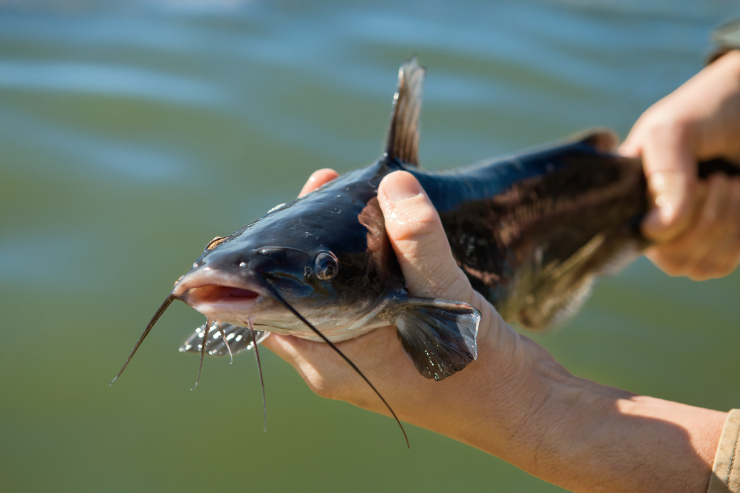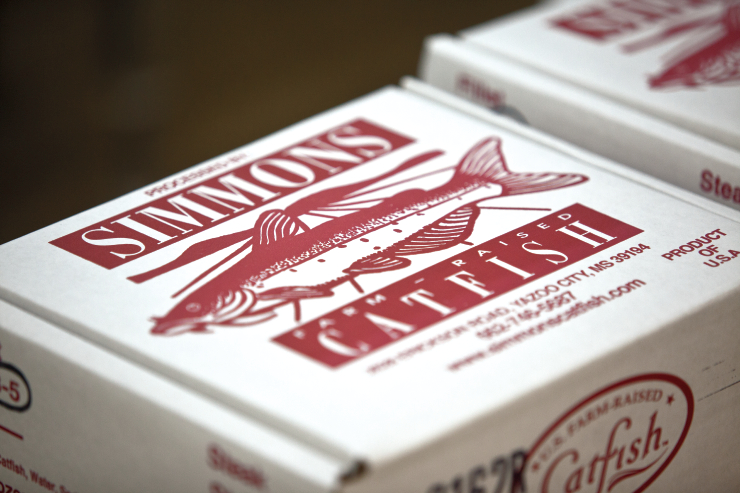Home > Mississippi > Mississippi Crops & Livestock > Reeling in the Catfish Market
Reeling in the Catfish Market
In partnership with: Mississippi Department of Agriculture and Commerce
 In many parts of the country, the words catfish and Mississippi conjure up images of Huck Finn, cane poles and long, lazy afternoons on the riverbank. In Mississippi, where hundreds are employed growing and processing the whiskery critter, catfish conjure up images of underwater livestock. More than 400 million pounds of catfish are farmed from hundreds of acres of ponds every year in the United States, and much of that is in Mississippi, a state where the clay soils and near-the-surface aquifers combine to make a perfect environment for aquaculture.
In many parts of the country, the words catfish and Mississippi conjure up images of Huck Finn, cane poles and long, lazy afternoons on the riverbank. In Mississippi, where hundreds are employed growing and processing the whiskery critter, catfish conjure up images of underwater livestock. More than 400 million pounds of catfish are farmed from hundreds of acres of ponds every year in the United States, and much of that is in Mississippi, a state where the clay soils and near-the-surface aquifers combine to make a perfect environment for aquaculture.
Introducing a New Crop
Many of those fish are grown and processed at Simmons Farm Raised Catfish Farm, Inc. in Yazoo City, where the owner, Harry Simmons, has been farming catfish since 1976. His farm employs more than 300 people and processes 18 to 25 million pounds of catfish annually from the region. Simmons got into the business more than 30 years ago because he was looking for something more stable than row crops. Aquaculture is capital-intense, so it took the right combination of factors to make it work. “I guess what interested me is catfish were pretty well suited to the farm I had with heavy clay soil that wasn’t so good for other crops. It allowed me to do something with that land that would give me a better return.” His company has moved more and more toward the processing of area catfish over the years rather than strictly growing them, but he still grows quite a bit and loves every aspect of what he does. “There are new challenges every day,” he says. “It’s a great product. I like selling it. We have some good customers who have been with us a long time.”
Fighting for the Market
Despite his love of the business, those challenges have grown for him and for much of the industry. Over the last few years, as tariffs on foreign catfish have been lifted, cheaper catfish from Vietnam has flooded the U.S. market. The introduction of millions of pounds of fish from Vietnam amounts to unfair competition, many U.S. catfish farmers say. That influx of fish combined with a troubled economy, high fuel prices and high feed prices, has pushed many catfish farmers out of the business all together. So the market dropped from more than 600 million pounds at its peak to 400 million in 2012, Simmons says. It might be a struggle to keep the numbers even that high in the future. “We’re battling to preserve this market,” Simmons says. “The drought this year has just made it all worse.” The downturn in catfish farming is particularly discouraging because it comes at a time when catfish farmers are making huge strides in innovation, technology and efficiency. Farmers are learning how to grow healthier fish on less acreage. It’s also discouraging because many catfish farmers think U.S. customers would choose American catfish over cheap imports if they knew more about the import issue. “The biggest reason to choose U.S. catfish: every catfish you get in the U.S. is inspected by the U.S. Department of Commerce,” Simmons says. “Of the fish that are imported, fewer than two percent are actually inspected by the Food and Drug Administration when they come into this country. And there’s a tremendous volume coming in to the country.” Simmons thinks Americans would buy domestic catfish over foreign catfish if they knew its origin, but in many cases the consumer is unaware of the country of origin.  “From the standpoint of food safety, I would rather buy from this country than I would from somewhere else,” he says. He expects attitudes about where food comes from to change even more in the coming years. For one thing, the catfish industry has lobbied hard to reverse those tariff decisions and draw attention to the issue. He also thinks the local food movement has pushed people to look for seafood harvested close to home. He also thinks consumers are beginning to look at food differently because of scares about food produced in some other countries. “While you might not need to know where your clothes are made, when it comes to a food item you need to be a little more skeptical about where it came from and how it was grown and packed,” he says. Roger Barlow, president of the U.S. Catfish Institute in Jackson, Miss., agrees that Americans should question catfish imports. “The product that’s coming into this country should be safe for the consumers,” Barlow says. “I don’t think there’s enough inspection of imported fish. “That’s not protectionism. It’s agriculture 101.”
“From the standpoint of food safety, I would rather buy from this country than I would from somewhere else,” he says. He expects attitudes about where food comes from to change even more in the coming years. For one thing, the catfish industry has lobbied hard to reverse those tariff decisions and draw attention to the issue. He also thinks the local food movement has pushed people to look for seafood harvested close to home. He also thinks consumers are beginning to look at food differently because of scares about food produced in some other countries. “While you might not need to know where your clothes are made, when it comes to a food item you need to be a little more skeptical about where it came from and how it was grown and packed,” he says. Roger Barlow, president of the U.S. Catfish Institute in Jackson, Miss., agrees that Americans should question catfish imports. “The product that’s coming into this country should be safe for the consumers,” Barlow says. “I don’t think there’s enough inspection of imported fish. “That’s not protectionism. It’s agriculture 101.”
Sustainable Agriculture
Barlow says he sees a number of challenges facing the industry. But he also sees innovation that will help farmers who have stayed in the business prosper. In addition to farming technology, chefs have begun to pay even more attention to catfish. Americans love catfish fried, but consumers and chefs are appreciating it more and more as a versatile food that is cut and prepared a myriad of ways. “I think consumers, once they taste our product, once they get it in their mouths, we’ve got them hooked,” he says. The farming industry and U.S. consumers will continue to seek out alternative crops and food from sustainable sources, Barlow says, and that bodes well for catfish. Ocean fish stocks are threatened with overharvesting as the world population grows. Aquaculture provides some solutions. “I think aquaculture is the ag frontier for the foreseeable future.”



